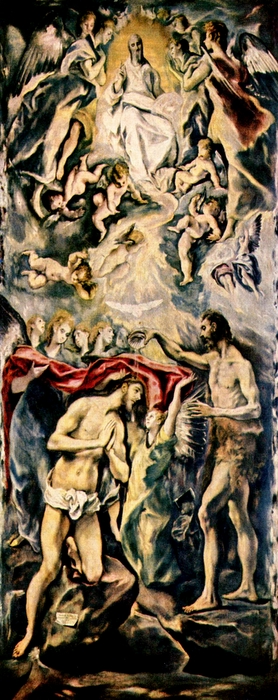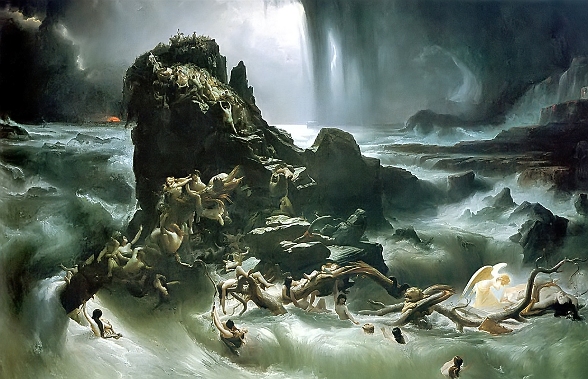
This Sunday, the first Sunday after Epiphany, celebrates the Baptism of the Lord by John the Baptist. In the Gospel for this day, Matthew 3:13-17, John doesn’t want to baptize Jesus: “I need to be baptized by you, yet you come to me?” But Jesus insists–“Allow me to be baptized now. This is necessary to fulfill all righteousness”–and John at last agrees.
Why this reluctance? Earlier, John had said,
I baptize with water those of you who have changed your hearts and lives. The one who is coming after me is stronger than I am. I’m not worthy to carry his sandals. He will baptize you with the Holy Spirit and with fire (Matthew 3:11).
John is not worthy to baptize Jesus–and indeed anticipates that Jesus has come to baptize him with the Spirit. But Jesus says that his own baptism is “necessary” first. What could this mean? Perhaps Jesus must be baptized to model the life of believers to come. But perhaps Jesus must be baptized in fulfillment of the model he himself is following.
We may find a window into what this means by considering other biblical texts concerning baptism. The apostle Paul famously found the waters of baptism to represent death and burial:
Or don’t you know that all who were baptized into Christ Jesus were baptized into his death? Therefore, we were buried together with him through baptism into his death, so that just as Christ was raised from the dead through the glory of the Father, we too can walk in newness of life. If we were united together in a death like his, we will also be united together in a resurrection like his (Romans 6:3-5).
 Jesus’ baptism prefigures his death and burial, while we who follow him are baptized “into his death”–dying to self and sin. Similarly the author of 1 Peter saw the waters of baptism in terms of death and destruction:
Jesus’ baptism prefigures his death and burial, while we who follow him are baptized “into his death”–dying to self and sin. Similarly the author of 1 Peter saw the waters of baptism in terms of death and destruction:
Noah built an ark in which a few (that is, eight) lives were rescued through water. Baptism is like that. It saves you now—not because it removes dirt from your body but because it is the mark of a good conscience toward God. Your salvation comes through the resurrection of Jesus Christ, who is at God’s right side. Now that he has gone into heaven, he rules over all angels, authorities, and powers (1 Peter 3:19-22).

Like Noah’s flood, which swept away a world, baptism marks for the believer the end of an old world and way of life, and entrance into a new world, in which one stands before God in “good conscience.” The means of salvation through water for Noah and his family was of course the ark. As I have discussed before, the term used for this construction is intriguing–and may point us toward another image for Jesus’ baptism, and ours.
In the Greek of the New Testament, the word used for Noah’s ark is kibotos (see also Matthew 24:38; Luke 17:27; Hebrews 11:7)–a word meaning, not “boat” or “vessel,” but “box.” In fact, that same word is used in both the New Testament and the Septuagint, the Greek translation of Jewish Scripture, not only for Noah’s ark, but also for another box: the Ark of the Covenant (see Exod 25:10, 14, 21; Heb 9:4; Rev 11:19) –although the Hebrew uses different words for that structure (‘aron, also meaning “box”) and Noah’s (Hebrew tebat).
The word tebat is a loanword from the Egyptian tbt, meaning “chest.” It appears in only two places in the Hebrew Bible: 26 times in Genesis 6—8 for Noah’s ark, and twice in Exodus 2, for the reed basket in which baby Moses was placed. You may have heard the old joke, “How many animals did Moses take on the ark?” “None—that was Noah and the ark.” Well, as it turns out, Moses did have an ark, and in the Hebrew a clear connection is made between Noah’s and Moses’ deliverance.
The story of Moses’ birth is told in Exodus 2:1-10. Moses was the child of a man and women of the priestly tribe of Levi. His birth was a great risk, since Pharaoh had sentenced all Hebrew baby boys to death by drowning in the Nile (Exod 1:22). His parents hid him as long as they could, but when he was three months old, they surrendered to the inevitable, and Moses’ mother and sister took him to the river themselves. But instead of drowning the baby, they put him in a tebat (rendered in the NRSV as “basket”) and set him afloat—hoping against hope, perhaps, that someone would find him and raise him in safety.

Not only is the same Hebrew word used both for Moses’ little ark and Noah’s enormous ark, but they are also prepared similarly: both are coated inside and out with tar, to make them water-tight (Genesis 6:14; Exodus 2:3). Just as Noah led his family and the world’s animals into his ark, after which the LORD closed the door (Gen 7:16), so Moses’ mother placed her son in his tiny ark, trusting him into the hands of God. Careful readers of Scripture, when they read of Moses’ ark, recall God’s deliverance of Noah, his family, and the world’s creatures in their ark, and know that as grim as Moses’ future seems at that moment to be, this baby, like Noah, will be saved through water.
The reader needs those reassuring links to Noah’s story! The little basket floats into the Egyptian princess and her attendants, who are bathing in the Nile (Exod 2:5-9). Surely this will be the end for Moses. Pharaoh himself had commanded that any Egyptian who found a Hebrew boy was to drown him in the Nile—and surely, if anyone could be expected to obey Pharaoh’s edicts, it was his own daughter! But instead, even though the Egyptian princess knew that this child must be one of the Hebrews, she decided to keep him and raise him as her own. Moses’ sister, who had been watching from the bank, stepped up with an offer to find a Hebrew wet-nurse for the baby, and so Moses was raised in Pharaoh’s household by Moses’ own mother!
As Dale Allison in particular has noted, Matthew understands Jesus, in many ways, as The New Moses (for example, Jesus goes down into Egypt and returns; see Matt 2:13-15). Perhaps, then, Matthew saw Jesus’ baptism as a necessary reflection of Moses’ river ordeal. Perhaps Jesus, like Moses, is passing through the water, showing his people the way to salvation. Pushing this parallel, we could ask where the ark is in Matthew–but then, perhaps that is the point. Jesus doesn’t need an ark. Jesus is the ark as well–saving us through the waters of death and destruction. With the great African-American gospel hymnist and preacher Charles Tindley, we can confidently pray:
When the storm of life is raging,
Stand by me.
When the storm of life is raging,
Stand by me.
When the world is tossing me
Like a ship upon the sea,
Thou who rulest wind and water,
Stand by me.
AFTERWORD:
In the Christian East, the liturgical year follows the old Julian calendar. By their reckoning, January 6 marked the beginning of Christmastide, not its conclusion. So, to our Orthodox sisters and brothers, a Merry Christmas!